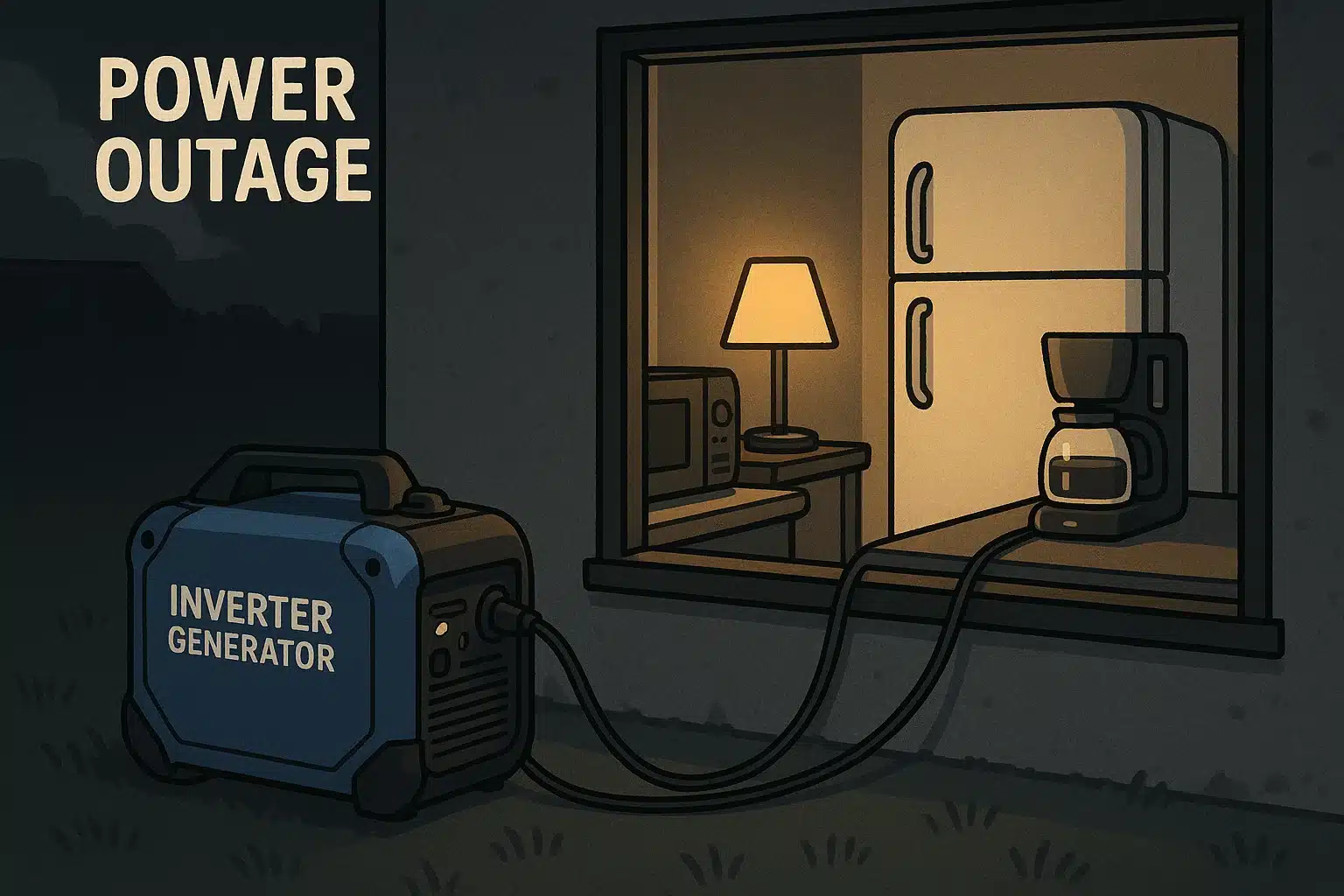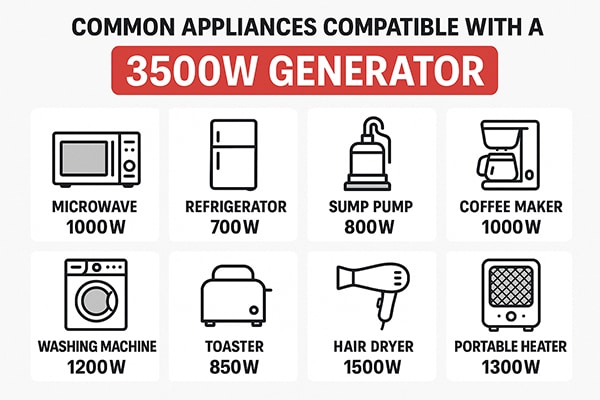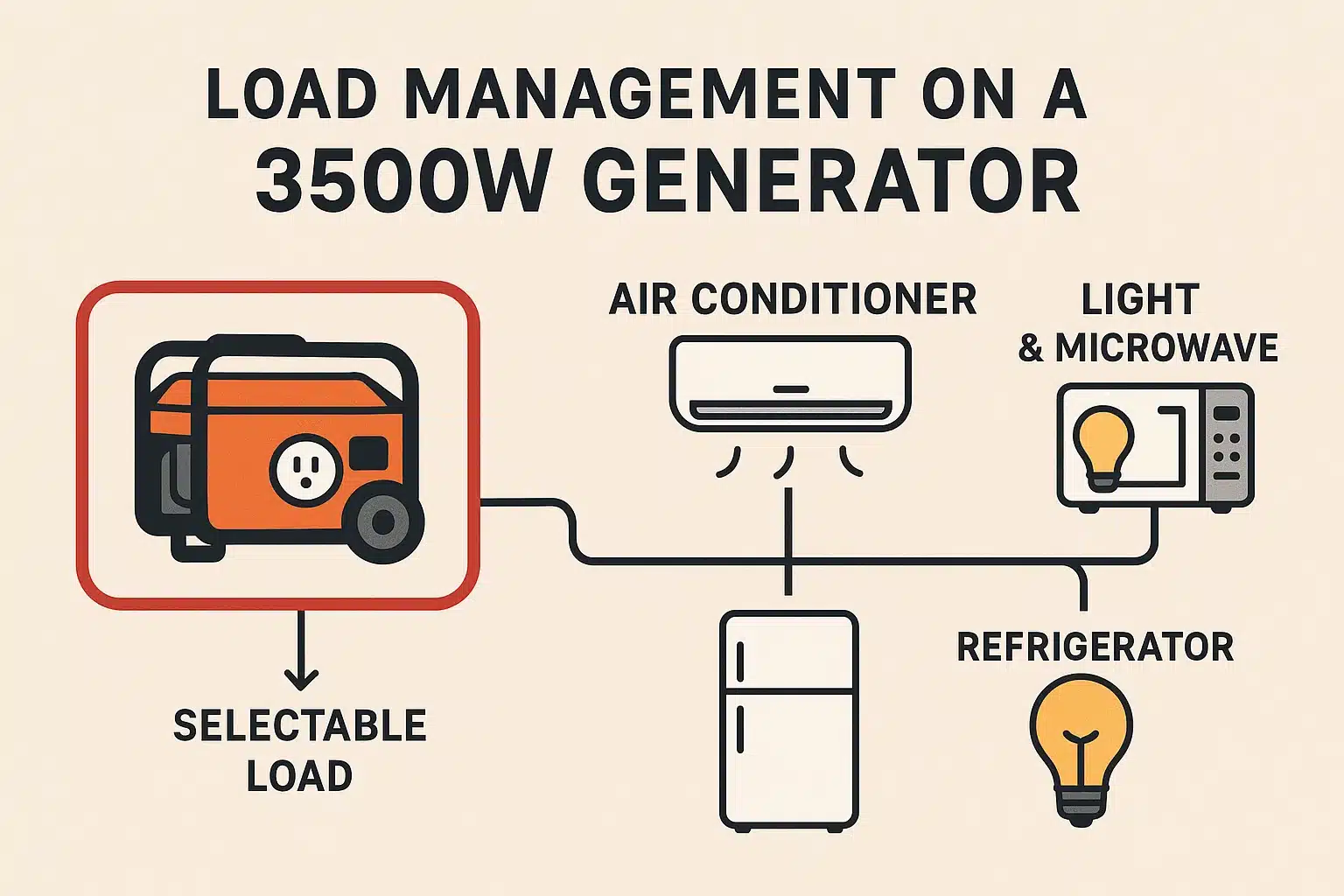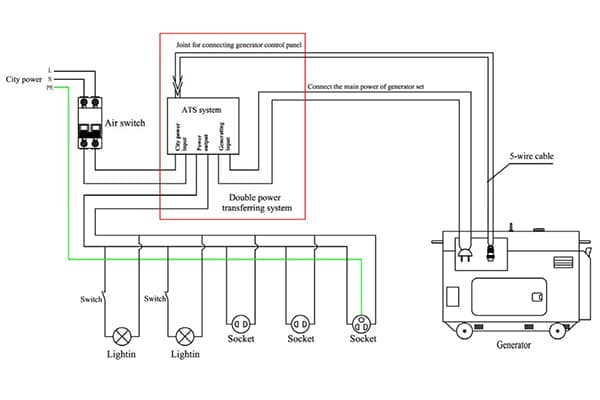Power out? Worried about keeping essentials running? A 3500-watt generator might be the perfect backup power source you need for peace of mind during an outage.
A 3500-watt generator reliably powers household essentials like refrigerators, freezers, sump pumps, lights, fans, and TVs. It can also handle some power tools, microwaves, or a small window AC unit, making it a versatile choice for home backup or job sites.

Understanding exactly what this size generator can handle is key before you buy or during an emergency. Let’s look closer at the specific appliances you can run, how many you can power simultaneously, and what you should absolutely avoid plugging in. Knowing this helps you make the most of your generator safely.
What can I run off a 3500 watt generator?
Confused about which specific items your 3500W generator can handle? Worrying about overloading it? Let’s clarify exactly what you can power up safely and effectively.
You can run refrigerators, freezers, lights, sump pumps, fans, TVs, computers, and charge devices. It often handles a small window AC, furnace fan, microwave, or coffee maker, plus many power tools like drills and circular saws.

To really understand capability, we need to talk about two types of power: running watts and starting watts. Running watts are the continuous power an appliance needs. Starting watts are the extra power needed for a brief moment when appliances with motors (like fridges or pumps) first turn on. A 3500-watt generator provides 3500 watts continuously but can often handle a higher peak load (surge watts) for those initial starts.
Understanding Power Needs: Starting vs. Running Watts
It’s critical to know the difference. An appliance might only need 700 watts to run, but require 2000 watts just to start up. Your generator needs to handle both. Always check the label on your appliance for its specific requirements. If it’s not listed, you can estimate using charts, but the actual label is best.
Here’s a table showing typical wattages for common items:
| Appliance | Typical Running Watts | Typical Starting Watts | Can a 3500W Run It? | Notes |
|---|---|---|---|---|
| Refrigerator/Freezer | 100-200 | 700-1200 | Yes | Essential, check specific model |
| Sump Pump (1/2 HP) | 800-1050 | 1300-2150 | Yes | Crucial for flood prevention |
| Lights (LED bulbs x5) | 50 | 50 | Yes | Very low power draw |
| TV (50" LED) | 100 | 100 | Yes | |
| Laptop | 50 | 50 | Yes | |
| Microwave (1000W) | 1000 | 1000 | Yes | Use intermittently |
| Coffee Maker | 600-1200 | 600-1200 | Yes | High draw, use alone if needed |
| Window AC (10k BTU) | 1200 | 1800 | Maybe | Borderline, check specific rating |
| Circular Saw (7 1/4") | 1400 | 2300 | Yes | Common power tool |
| Furnace Fan (Gas/Oil) | 300-750 | 700-1500 | Yes | Important for heating in winter |
I always advise clients to list their absolute must-have items first during an outage. Then, add the nice-to-haves and see if the total wattage fits within the generator’s capacity. A 3500W generator often covers the essentials comfortably.
How many appliances can a 3500 watt generator run at once?
Want to run multiple things on your generator? Scared of tripping the breaker or damaging items? Let’s figure out how to manage the load safely.
You can run several appliances simultaneously as long as their total running watts stay below 3500W. Crucially, the generator must also handle the highest starting wattage demand when added to the existing running load.

It’s not just about the number of appliances, but their combined power consumption. You need to perform simple calculations to avoid overloading the generator. Overloading can trip the generator’s circuit breaker or, worse, damage the generator or your connected appliances. Careful planning is key.
Calculating Your Power Load
- List Appliances: Write down everything you want to run at the same time.
- Find Watts: Note the running watts for each item. Also, note the starting watts for items with motors.
- Calculate Running Total: Add up the running watts of all appliances you plan to run simultaneously. This total must be less than 3500W.
- Check Starting Load: Identify the appliance with the highest starting wattage. Add this single highest starting wattage to the running watts of all other appliances that will be on when it starts. This total must be less than the generator’s peak/surge wattage rating (often higher than 3500W, check your manual).
Example Scenario:
Let’s say you want to run:
-
Refrigerator (150W running / 700W starting)
-
Sump Pump (800W running / 1300W starting)
-
Five LED Lights (50W running / 50W starting)
-
TV (100W running / 100W starting)
-
Running Total: 150W + 800W + 50W + 100W = 1100W (Well below 3500W)
-
Starting Load Check: The highest starting watts belong to the Sump Pump (1300W). When it starts, the other items are running: 1300W (Pump Start) + 150W (Fridge Run) + 50W (Lights Run) + 100W (TV Run) = 1600W surge needed. Most 3500W generators have a surge capacity higher than this (e.g., 4000-5000W), so this is likely fine.
Pro Tip: Stagger the startup of high-wattage items. Don’t turn on the microwave right when the refrigerator compressor kicks on. Let one start, then start the next.
What should I not plug into a generator?
Worried about damaging sensitive electronics or the generator itself? Plugging in the wrong thing can be costly or dangerous. Know what to avoid connecting for safety.
Never exceed the generator’s 3500-watt running capacity. Critically, do not connect the generator directly to your home’s electrical panel or outlets without a professionally installed transfer switch (backfeeding is illegal and dangerous). Be cautious with sensitive electronics.

Using a generator safely involves knowing its limits and potential hazards. Certain practices or connections can damage your equipment, create fire risks, or even pose lethal threats to utility workers. Awareness is your best defense against these dangers.
Key Things to Avoid:
-
Overloading:
- Why: Trying to draw more than 3500 continuous watts will trip the circuit breaker. Repeatedly doing this can strain the generator.
- Solution: Calculate your load carefully, as discussed before. Prioritize essential items.
-
Backfeeding:
- Why: Plugging your generator directly into a standard wall outlet is extremely dangerous and often illegal. It sends electricity back through the utility lines (backfeeding), which can electrocute utility workers trying to restore power. It also bypasses your home’s circuit breaker protections, creating a fire hazard.
- Solution: Use heavy-duty extension cords run directly to appliances. For powering circuits in your home, always use a manual transfer switch installed by a qualified electrician. This safely isolates your home from the grid when the generator is active. I’ve seen the tragic results of backfeeding; it’s simply not worth the risk.
-
Connecting Very Sensitive Electronics (Sometimes):
- Why: Standard portable generators can produce power with higher Total Harmonic Distortion (THD) compared to utility power. This "dirty" power can sometimes damage sensitive electronics like computers, laptops, modern TVs, or devices with microprocessors.
- Solution: Use an inverter generator if you need to power sensitive devices. Inverters produce much cleaner power (low THD). If using a standard generator, plug sensitive electronics into a quality surge protector specifically designed for generator use, but understand it’s not foolproof.
-
Appliances Exceeding Capacity:
- Why: You simply cannot run large appliances that require significantly more power than 3500 watts.
- Examples: Central air conditioners, electric clothes dryers, electric water heaters, electric ranges/ovens typically require 5000W or much more.
- Solution: Plan to run only compatible essentials and smaller appliances within the 3500W limit.
Safety First: Remember the most basic rule: Never operate a generator indoors, in garages, basements, or near windows/vents. Generators produce deadly carbon monoxide (CO). Always run them outdoors, far from occupied areas, with the exhaust pointing away.
Conclusion
A 3500-watt generator powers essential appliances and tools effectively. Remember to manage the load by calculating watts, stagger startups, and never backfeed. Use a transfer switch for home connections.
